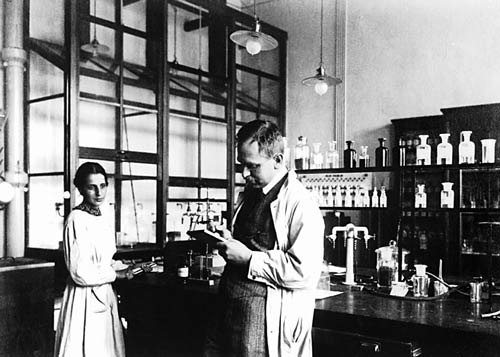A nuclear phenomenon that escaped the hands of physicists

Otto Hahn and Lise Meitner
Otto Hahn and Lise Meitner frequently worked together, as can be seen in this 1918 photograph made when they discovered the protactinium. Twenty years later, in 1938, they made the discovery of nuclear fission that won them international fame. German physicist and chemist, Otto Han (1879-1968) won the Nobel Prize in 1945. Lise Meitner (1878-1968) was born in Vienna and studied at university there as well as in Berlin. She was a professor of physics at the Berlin University between 1926 and 1933, leaving Germany in 1938 to join the atomic research staff at Stockholm University. In 1939, Lise Meitner published the first scientific article explaining nuclear fission.
© DR
In the years spanning 1934 to 1938, Enrico Fermi with his team in Rome, Otto Hahn and Lise Meitner in Berlin, Irene Curie and Paul Savitch in Paris discovered a large number of new radioisotopes. They all attempted to create heavier, ‘transuranic’, elements by bombarding uranium with neutrons.
It was in 1938 that Otto Hahn and Fritz Strassman, using previous works of Irène Curie and Savitch, were able to make precise chemical analyses of these heavier elements, and discover that bombarded uranium nuclei give sometime rise to two new, surprisingly lighter, elements.
Lise Meitner, now forced to leave Germany for a life in Sweden, was visited by her nephew Otto Frisch, who was then living in Copenhagen. Together, the two became the first to interpret this observed phenomenon, and concluded that the two products of the uranium splitting were of approximately equal size. Their results were published in the magazine ‘Nature’ in February 1939.
A series of elegant experiments carried out by Frederic Joliot on late January 1939 were able to provide the necessary physical evidence. Within the month, he was able to observe products of the uranium fission reaction in the Wilson chamber in his laboratory at the Collège de France in Paris.
Joliot immediately began wondering about the possibility of setting off a chain reaction. Uranium contains a higher neutron-proton ratio than in both the lighter fragments it produces, which means that some free neutrons must be emitted by these fragments richer than normal in neutrons. These neutrons could then, in turn, induce one or more new fission reactions under conditions which would have to be carefully determined. With Hans Halban and Lew Kowarski, Joliot was able to carry out experiments to examine the possibility of starting a chain reaction.
On May 1939 (the 1st, 2nd and 4th of May, to be exact), the three physicists were joined by Francis Perrin to take out three patents in the name of the ‘Caisse Nationale de la Recherche Scientifique’: Device for energy production, Method for stabilizing a device for energy production and Method for perfecting explosive charges.
The war erupted in 1939. Scientists were conscious of the fantastic energy released by chains of fission reactions. Leo Szilard, an Hungarian born physicist, convinced Albert Einstein to use his authority as a leading scientist to alert the US president F.D. Roosevelt. The physics research being conducted in Europe crossed to the Atlantic, escaping the hands of physicists. Enrico Fermi build the world first ‘atomic pile’ in Chicago in 1942. This was the beginning of the Manhattan project that led to the atomic bomb in 1945.
NEXT : Enrico Fermi
Other articles on the subject « Discoveries »
Marie Curie
Marie Curie Marie Sklodowska-Curie had an exceptional destiny. Born in Poland, she came to gradua[...]
Three radiations
Understanding the nature of alpha, beta and gamma rays In the years following the discovery of ra[...]
Discovery of the Nucleus
A new vision of the atom In 1911, Rutherford, Marsden and Geiger discovered the dense atomic nucl[...]
Ernest Rutherford
In October 1895, landed in England a 24 years-old young New Zealander. His name was Ernest Ruther[...]
Rutherford’s experiment
The experiment which proved the existence of a nucleus in the atom In 1908, Ernest Rutherford rec[...]
The neutron : Chadwick
A close competition between great physicists … James Chadwick, who discovered the neutron i[...]
Radium and Medicine
A short history: first steps in nuclear medicine … Everyone knows that the discovery of rad[...]
1934 : Artificial Radioactivity
The production at will of radioactive isotopes In the first days of 1934, Frederic and Irene Joli[...]
The Neutrino Hypothesis
The remarkable story of the neutrino The study of radioactive disintegrations had established tha[...]
Enrico Fermi
A genial experimenter and theoretician Enrico Fermi (Rome, September 29, 1901 – Chicago, No[...]